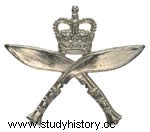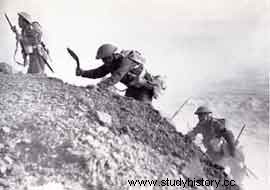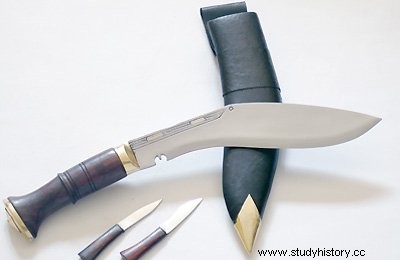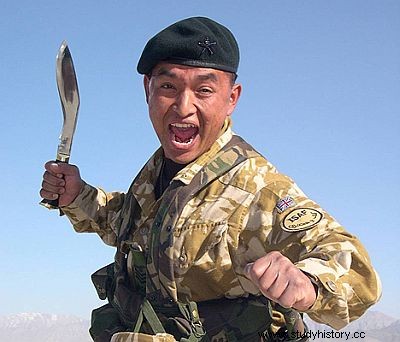The Gurkhas are members of the Rajput Khasi clan of northern India who migrated from Rajasthan to what is now Nepal in the 16th century, driven out by the Muslims. Their language, Gurkhali, an Indo-European dialect close to Hindi, has become the common language of Nepal under the name Nepali or Nepali.

Legend and history
The genesis of the Gurkhas
According to legend, during the 8th century, the young prince Bappa Rawal, born prince Kalbhoj, founder of the dynasty of Mewar, would have discovered the holy warrior Gurû Gorkhanath - in fact the philosopher Goraknâth or Gorakshanâtha (undetermined date between the 10th and 14th centuries) - in deep meditation, while hunting with friends in the jungles of Rajasthan.
He then decides to stay with the saint and protect him during his meditation. When he returns to the world, he is touched by the devotion of the prince. He offers him the Kukri dagger, tells him that henceforth he and his men will be known throughout the world for their bravery and names them Gurkhas, that is to say disciples of Gorkhanath. He then gave the Gurkhas the mission of stopping the advance of the Muslim invaders who were in the process of seizing white India, that is to say Afghanistan (called Qandahār at that time) which was then a Hindu and Buddhist kingdom. They will fulfill this mission until the 8th century.
Some legends claim that Bappa Rawal then continued his campaigns to conquer Iran and Iraq before retiring for a life of asceticism at the foot of Mount Meru.
In 1559, some of the Gurkhas, descendants of Bappa Rawal, and led by their chief Dravya Shâh emigrated towards the east and carved out a small kingdom on the territory of present-day Nepal, 80 km north-west of Kathmandu, territory to which they give the name Gorkha in honor of their patron saint. In 1769, under the leadership of the mahârâja Prithivî Nârâyan Shâh, who reigned until 1775, they seized the majority of the current territory of Nepal, then directed by the Malla, and settled in Kathmandu where they made Hinduism the state religion.
In 1788, then in 1791, the Gurkhas invaded Tibet and plundered the monastery of Tashilhunpo in Shigatse. In 1792, Tibet asked for help from China to get rid of its invaders.
The Gurkhas and the English conquest
From 1814, they tried to expand their territory to the south and opposed the interests of the English East India Company, which led to the Anglo-Gurkha War (1814-1816). Defeated, they signed the Treaty of Saugali in November 1815, rebelled again and were crushed at Makwanpur in 1816. During this war, the British were so impressed by their bravery that they were soon to recruit them regularly, with the permission of the first then Minister, Shree Teen Maharajah Jung Bahadur Rana (father of modern Nepal), as mercenaries organized into regiments of Gurkhas within the company army.

The Gurkhas are then classified into two categories:the Thâkur/Rajput Gurkhas , who consider themselves to be the descendants of the original Gurkhas and who agree to serve only as officers and the Tibeto-Mongolian Gurkhas who agree to start their careers as privates. One of the first Thâkur/Rajput, General Narendra Bir Singh, of the Gurkha Rifles, would even become Mountbatten's aide-de-camp. After Indian independence, Gurkha Thakur/Rajput refuse to serve in the British army but allow Tibeto-Mongols to serve.
According to international law, the Gurkhas integrated today into the British army are not considered mercenaries but as soldiers fully integrated into this army, formed into a brigade of Gurkhas, and subject to the laws and regulations which govern all British soldier. An equivalent system governs Gurkhas serving in the Indian Army.
Army of the English East India Company
The Gurkhas served as contract troops for the British East India Company during the Pindari War of 1817, at Bhurtbore in 1826 and during the Anglo-Sikh Wars, (1845-1846) and (1848-1849). /P>
During the Sepoy Rebellion in 1857, the Gurkhas fought on the side of the British and became part of the British army which was formed after it. The 2nd Gurkha Rifles - or Sirmoor Rifles - defend the Hindu Rao House, a strategic position, for three months losing 327 of the 490 men who make up the regiment.
The men of the 60th Rifles (later the Royal Green Jackets) who fought alongside the Sirmoor Rifles were so impressed that after the mutiny they demanded that the 2nd Gurkhas be rewarded by adopting their distinctive riflemen's green uniform and that his men be called fusilliers instead of sepoys.
British Indian Army
From the sepoy revolt to the First World War, Gurkha regiments served in Burma, Afghanistan, the North-East and North-West territories of India, Malta during the Russo-Turkish War of 1877-1878, in Cyprus, Malaya, China (during the Boxer Rebellion of 1900) and Tibet (during Francis Younghusband's expedition in 1903).
Between 1901 and 1906 the regiments of Gurkhas were renumbered from 1st to 11th and renamed Gurkha Rifles. One hundred thousand of them participated in the First World War, in France at Loos where the 8th Gurkhas fought to the last, Givenchy, Neuve-Chapelle and Ypres; in Mesopotamia, Persia, on the Suez Canal and in Palestine (to hold back the Turkish advance), in Gallipoli and Salonica. A detachment serves under the command of Lawrence of Arabia.
Between the two wars, the Gurkhas took part in the third Afghan war in 1919 as well as in numerous campaigns on the north-western frontier, particularly in Waziristan.
From 1920, a Gurkha could also receive a command from the King of India, which makes him considered a British officer. Nevertheless, this fact was quite rare until the Second World War.
During the Second World War, the Nepalese crown authorizes the recruitment of twenty additional battalions, to reach a total of forty. The Gurkhas then fought in Syria, North Africa, Italy, Greece as well as against the Japanese in Singapore and in the Burmese jungle. The 4th Battalion of the 1st Gurkhas Rifles formed the core of the Chindits.
Units of Gurkhas between 1800 and 1946
* 1st Gurkha Regiment of King George V (The Malaun Regiment, created in 1815, integrated into the Indian Army in 1947)
* 2nd Regiment of Gurkhas of King Edward VII (The Sirmoor Rifles, created in 1815, integrated into the British Army in 1948)
* Queen Alexandra's 3rd Regiment of Gurkhas (established in 1815, integrated into the Indian Army in 1947)
* 4th Prince of Wales's Gurkha Regiment (established 1857, integrated into the Indian Army in 1947)
* 5th Regiment of Gurkhas (frontier forces, created in 1858, integrated into the Indian army in 1947)
* 6th Gurkha Regiment, renamed Queen Elizabeth's 6th Gurkha Regiment in 1959 (formed with the 42nd Gurkha Regiment of the Cuttack Legion created in 1817, integrated into the British Army in 1948)
* 7th Regiment of Gurkhas, renamed the Duke of Edinburgh's 7th Gurkha Regiment in 1959 (created in 1902, integrated into the British Army in 1948)
* 8th regiment of Gurkhas (issued in 1903 with the 44th regiment of Gurkhas of the 16th local battalion (Sylhet) created in 1824, integrated into the Indian army in 1947)
* 9th Regiment of Gurkhas (created in 1817, integrated into the Indian Army in 1947)
* Princess Mary's 10th Regiment of Gurkhas (established 1890, integrated into the British Army in 1948)
* 11th Gurkha Regiment (1918-1922; re-established in 1947 after Indian independence)
* 14th regiment of Gurkhas (1942-1946)
* 25th regiment of Gurkhas (1942-1946)
* 26th regiment of Gurkhas (1943-1946)
* 29th regiment of Gurkhas (1943-1946)
* 38th regiment of Gurkhas (1943-1946)
* 42nd regiment of Gurkhas (issued with the 6th regiment of Gurkhas of the Cuttack Legion created in 1817)
* 44th regiment of Gurkhas (issued in 1903 with the 8th regiment of Gurkhas of the 16th local battalion (Sylhet) created in 1824)
* 56th regiment of Gurkhas (1943-1946)
* 710th regiment of Gurkhas (1943-1946)
Independence of India (1947)
Equivalence of ranks between the Indian army and the British army
After Indian independence (and its partition) in 1947, the fate of the Gurkhas was settled by a tripartite agreement between India, Nepal and the United Kingdom. The main purpose of this agreement was to ensure Gurkhas serving the British Crown the same salary and salary scale as those who remained in the Indian Army. This scale, clearly lower than the standards of the British army, was partially compensated by the cost of living and the housing facilities granted. However, the retirement pension paid to Gurkhas was lower for those who served in the former colonial power upon their return to Nepal.

In application of this agreement, six regiments of Gurkhas joined the army Indian army and four others were transferred to the British army.
Much to the disappointment of their officers, the majority of Gurkhas who had been given the choice between service in the British or Indian army opted for the latter. The reasons for this choice are very pragmatic and the fact that the Indian army continues to serve in familiar territory under known conditions weighed heavily in this choice. The main change was the replacement of British officers by Indian officers.
The four regiments designated to serve in the British army, for their part, had to face an uncertain situation, an (initial) move to Malaya, a region where very few Gurkhas had then served. The four regiments (eight battalions) in service with the British army were therefore reduced to one (i.e. 2 battalions) while those in service with the Indian army were increased to 12 battalions.
Units of Gurkhas after 1947
British Army Gurkhas
* King Edward VII's 2nd Regiment of Gurkhas (The Sirmoor Rifles)
* Queen Elizabeth's 6th Regiment of Gurkhas
* Duke of Edinburgh's 7th Gurkha Regiment
* 10th Regiment of Princess Mary's Gurkhas
They were grouped within the Gurkha Brigade, initially stationed in Malaysia. Later moved to Hong Kong, they left Asia when the island returned to Chinese rule in 1997.
Indian Army Gurkhas
* King George V's 1st Gurkha Regiment (The Malaun Regiment)
* Queen Alexandra's 3rd Regiment of Gurkhas
* 4th Prince of Wales Gurkha Regiment
* 5th Gurkha Regiment
* 8th Gurkha Regiment
* 9th Gurkha Regiment
Following independence, the Gurkhas were renamed Gorkhas. Also, an additional regiment, the 11th Gurkhas Regiment was raised. When India became a republic in 1950, all royal titles were abolished.
Modern history of the Gurkhas
Indian units
The 1st Battalion of the 11th Gurkha Regiment fought in the 1999 Kargil Conflict in India.
In 1999, the 5th Battalion of the 8th Gurkha Regiment was part of the Indian contingent of the United Nations Mission in Sierra Leone to protect the diamond mines against the forces of the United Liberation Front.
British units
In Malaysia, new units were created:sappers, transmitters, military police and transport unit joined the ranks of the Gurkha Brigade.
In 1962, the 2nd Gurkha Rifles left Asia for the British garrison at Tidworth (in Wiltshire). The Indonesian revolt in 1963 saw the creation of the first parachute unit for the Gurkhas (the Gurkha Independent Parachute Company). This unit quickly became a commando unit employed with the Special Air Service. This unit was disbanded in 1972.
At the end of the conflict, the units were redeployed to Hong Kong, where they were confined to security missions, particularly during the events of the Chinese Cultural Revolution.
In 1971, the 7th Duke of Edinburgh's Gurkha Rifles was transferred to Great Britain (to Church Crookham in Hampshire). It then became the first unit of Gurkhas to guard the Queen.
In 1974, Turkey invaded Cyprus and the 10th Gurkha Rifles was sent there to ensure British sovereignty over the Dhekelia base. They remained there as a peacekeeping force.
On July 1, 1994, the four regiments were consolidated into one, the Royal Gurkha Rifles, and the other three specialist corps (the Military Police had been disbanded in 1965), were reduced to squadron size.
On July 1, 1997, the British government returned Hong Kong to the People's Republic of China and the size of the Gurkha Brigade was further reduced to 3,400 men. All remaining units were sent to Great Britain.
The Gurkhas also participated in the Falklands Wars (with the 1st Battalion of the 7th), the Gulf War, NATO operations in Kosovo, and United Nations peacekeeping operations in Bosnia and East Timor.
They were also engaged in Sierra Leone and serve regularly in Iraq.
Singapore's Gurkha Contingent
The Gurkha Contingent (or GC for Gurkha Contingent) of the Singapore Police Force was formed on April 9, 1949 by recruiting Gurkhas, veterans of the British Army. It was created to replace a Sikh unit disbanded during World War II and is an integral part of the police force.
This particularly well-trained, dedicated and disciplined unit is a reserve guard unit. In times of crisis, it can be deployed as an impartial rapid reaction force. During the turbulent years following independence, the unit performed many policing duties during the riots. The Gurkhas displayed a courage, self-control and professionalism that earned them the respect of the people.

Since the events of September 11, 2001, the Gurkha contingent is sometimes seen patrolling the streets, and replacing local police officers guarding key installations. Before the incident they rarely appeared in public.
Units of Gurkhas in the British Army in 2006
* The Royal Gurkha Rifles (RGR) consisting of
o 1st Battalion The Royal Gurkha Rifles
o 2nd Battalion The Royal Gurkha Rifles
* the Queen's Gurkha Engineer (QGE) composed of:
o 69th Field Squadron
70th Support Squadron
these two squadrons are part of the 36 Engineer regiment
* The Queen's Gurkha Signals (QGS) composed of:
o 246th Gurkha Signal Squadron
o 250th Gurkha Signal Squadron
* The Queen's Own Gurkha Logistic Regiment composed of:
o 1st Transport Squadron
o 28th Transport Squadron
o 94th Blinds squadron
as well as several other smaller units:
* Company of Brecon Infantry School Maneuver Troops;
* Company of Maneuver Troops from Catterick Infantry Training Centre;
* Company of Sandhurst Officers School Maneuver Troops;
* Gurkha Brigade Training Unit;
* Catterick Language School;
* Gurkha Brigade music.
Distinctions and differences
At the time of colonization, and as opposed to British officers who received their command from the king or queen, Gurkha officers received theirs from the Viceroy. At the end of independence, for the regiments of Gurkhas who joined the British army, the Gurkha officers were called:Queen's Gurkha Officier (or King's Gurkha Officier QGO or KGO) in order to mark their difference. This distinction meant that they could not command British soldiers. This is no longer current today but the name is nevertheless kept as a tradition and Gurkha officers wear this inscription (QGO or KGO) on their rank insignia.
While in principle in the British army a subject can claim to enlist directly as an officer and thus have a command, the equivalent is not appropriate for the Gurkhas. It was customary for a Gurkha to prove himself first and rise through the ranks before his unit offered him a command.
The treatment of Gurkhas and their families, in accordance with the tripartite agreement between Britain, India and Nepal, has been the subject of much discussion in the United Kingdom following the revelation of the differences in wages between the British soldiers and their Nepalese counterparts.
Furthermore, the status and nationality of Gurkhas and their families is also a matter of contention. Indeed, under this agreement, the authorization to reside in Great Britain was not systematically given to these soldiers at the end of their time of service under the flags.
Nevertheless, since 2005, equal pay has been established and, once retired, Gurkhas can more easily apply for (and be granted) a residence permit.
Decorations and awards
Soldiers in Gurkha units have won 13 Victoria Crosses. All these medals, except that of Rambahadur Limbu, were won while the Gurkha regiments were still part of the Indian army. In addition, 13 Victoria Crosses were awarded to British officers serving in these units. Since independence, the Gurkhas have also gained 3 Param Vir Chakras.
In addition, these soldiers are famous for their traditional wide curved knife called kukri.
All Gurkhas, whatever their ethnic origin, speak Nepali, a language of Indo-European origin. The British officers serving in their units all first complete an internship at the Anglo-Nepalese language school in Catterick in order to learn the basics of this language.
Flag of the National Liberation Front of Gorkhaland
Flag of the National Liberation Front of Gorkhaland
In the mid-1980s, a Nepali-speaking group from West Bengal attempted to organize secession by creating the Gorkhaland National Liberation Front. In 1988, they were given relative autonomy by creating the Gurkha High Council of Darjeeling.
Recruitment of Gurkhas
From an ethnic point of view, the Gurkhas currently serving in the British army are of Indo-Tibetan-Mongolian and Aryan types. The Indo-Tibeto-Mongol type Gurkhas mainly belong to the Gurung, Magar, Tamang, Khasa and Kiranti groups. Many of them are followers of Tibetan Buddhism or shamanism.
Selection tests for incorporation take place once a year, on site, in Nepal.
At the end of the test, 230 candidates will join the British army; Another 77 will take their place in the Singapore police force's Gurkha contingent. A variable number will be recruited by the Indian Army.
